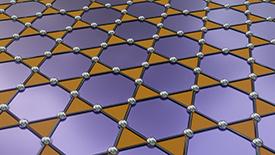

03/28/2022

© 2022 Patrick Han
An AIMR-led team has combined angle-resolved photoemission spectroscopy (ARPES) with density functional theory (DFT) to investigate how carrier injection affects the electronic structure of a kagome metal1. The observed carrier injection-dependent electronic-structure change indicates the multi-orbital origin of the CsV3Sb5 charge-density wave (CDW). These results suggest that future modeling of kagome metals must consider the multi-orbital effects.
When atoms form complex crystalline structures, such as the Star-of-David lattices in kagome metals (see Figure), the resulting correlated electronic systems are expected to produce exotic quantum properties through intricate mechanisms.
Recent measurements of CDWs and low-temperature (2.5 K) superconductivity in single crystals such as CsV3Sb5 further support the possibility of other kagome-metal exotic states (e.g., Weyl magnets, density wave orders, and anomalous quantum Hall states).
However, even with the many discoveries, demonstrating how the exotic states of kagome metals can be manipulated into applicability remains elusive.
“Most studies on kagome metals have been done on single crystals grown without defects or dopants,” says Kosuke Nakayama, the first author of the study. “We want to perturb the kagome-metal structure in a controlled way to find out how its correlated electrons can be manipulated from the resulting changes.”
Focusing on the effects of carrier injection, the team doses Cs atoms onto the surface of a CsV3Sb5 single crystal and combines ARPES and DFT simulations to interrogate the perturbed electronic changes over a wide temperature range.
This way, the team determines that while carrier injection does not affect the CsV3Sb5 saddle point, it induces the orbital-dependent band shifts of other electronic features. Specifically, the gradual CDW suppression by carrier injection indicates that several orbitals may be contributing to the occurrence of this superconductivity-associated feature.
“Prevalent theoretical works have used the single-orbital model to study kagome metals.” says Nakayama. “Our results suggest that the multi-orbital effects must be considered when modeling the exotic features of these complex materials.”
Future directions will determine both the role of carrier injection in superconductivity, and how this doping technique can be used to enhance other exotic properties near the boundary of the CDW phase.
(Author: Patrick Han)
This research highlight has been approved by the authors of the original article and all information and data contained within has been provided by said authors.